
Do you want to know how to become a diagnostic radiologist? Are you interested in a medical career that provides not only patient care but also offers unique opportunities for medical research and a chance to be on the cutting edge of modern medicine?
If so, a diagnostic radiologist career may be the perfect choice for you. In this blog post, I will explain what a diagnostic radiologist does and how to become one, even if you’re only in high school.
Summary:
- Diagnostic radiologists specialize in taking and interpreting medical images to diagnose and treat patients.
- Diagnostic Radiology residency training is five years, with the option of fellowship training afterward.
- Attending a top medical school may help a bit. But how you do on your USMLEs (Board) scores and in your med school class ranking will matter more.
- Non-PhD degrees like MBAs and MPHs appear to have a negligible advantage (1%) to become a radiologist.
Table of Contents
What Are Diagnostic Radiologists?
Diagnostic radiologists specialize in taking and interpreting medical images to help diagnose, monitor, and treat various conditions or injuries. Unlike popular belief, radiologists do not spend all their time in a dark room but they constantly interact with patients.
Radiologists consult with referring doctors and patients to diagnose and determine the best course of action. They evaluate patients’ medical histories to ensure the various medical imaging procedures will not harm them. They also play a vital role in assessing patients presenting with traumatic and nontraumatic emergencies.
As a diagnostic radiologist, you can work as a teleradiologist. This means you will be able to read and interpret imaging tests from anywhere in the world.
Is a Diagnostic Radiologist a Doctor?
Yes, diagnostic radiologists are doctors. They are often confused for radiographers (radiologic technologists) or radiologic nurses (RN). The radiographer and RN work under the supervision of a diagnostic radiologist.
A diagnostic radiologist is a specialized physician who has completed medical school, usually followed by a five-year residency in diagnostic radiology. During this period, the radiologist learns to apply imaging modalities to diagnose medical conditions.
Diagnostic Radiologists vs. Radiographers vs Interventional Radiologists: What’s the Difference?
Radiographers perform medical scans and maintain the equipment used for them. While diagnostic radiologists interpret these images to diagnose diseases and other medical conditions.
Interventional radiologists use medical imaging to guide minimally invasive surgical procedures to diagnose and treat patients.
Radiographers must graduate from an accredited program and pass a certification exam administered by the American Registry of Radiologic Technologists. This is more challenging for radiologists, as illustrated below.
How Long Does It Take To Become a Diagnostic Radiologist?
Becoming a diagnostic radiologist is difficult and requires considerable time and energy. But if you’re up to the challenge, the results are gratifying.
It takes 13 years of training after high school to become a diagnostic radiologist. This will consist of four years of undergraduate education, an additional four years of medical school, and five years of diagnostic radiology residency follow. Diagnostic radiology residents complete a 5-year residency program including a year of transitional training in internal medicine, pediatrics, or general surgery. Along the way, you’ll have to take standardized exams, including the SAT, the MCAT, and the USMLE Step 1 and Step 2 CK.
Undergraduate (4 Years)
The first step to becoming a radiologist is entering and completing an undergraduate program. This means taking the SATs and doing well enough to be accepted into a college or university. Once accepted into an undergraduate program, you’ll have to complete a minimum of four years of academic coursework. This includes classes in biology, chemistry, physics, English, and other general education courses.
Medical School (4 Years)
The next step is to take the MCAT, a standardized exam that measures your knowledge and skills in biology, chemistry, physics, and psychology. You’ll need to score well on the MCAT for med school acceptance.
You’ll have to complete four years of academic and clinical training during medical school. This includes classes in anatomy, physiology, pharmacology, pathology, and other medical topics. You’ll also have to complete clinical rotations at hospitals and other healthcare facilities to gain hands-on experience.
Diagnostic Radiology Residency (5 Years)
After you’ve completed medical school, you’ll have to match into a diagnostic radiology residency. To do this, you’ll have to take the USMLE Step 1 and Step 2 CK exams. These exams measure your knowledge and skills in the areas of clinical medicine. Once you’ve passed these exams, you’ll be eligible to apply for residency.
Once you’ve matched into a diagnostic radiology residency, you’ll have to complete a preliminary internship year, followed by four years of clinical training to become a radiologist. During this training period, you’ll learn how to interpret medical images, diagnose conditions and create treatment plans.
Fellowship (Optional; Usually 1 Year)
After completing your diagnostic radiology residency, you may pursue further training in a specialized area of diagnostic radiology. Radiology fellowships allow physicians to gain subspecialty expertise. Fellowship choices include cardiothoracic, cardiac, abdominal, and nuclear radiology. Most radiology fellowships are one year in length, allowing radiologists to gain additional experience and hone their skills in a specific area of radiology.
After Diagnostic Radiology Residency: Licensing + Board Certification
Upon completing your residency, you’ll be eligible to apply for a medical license. You need this to practice. You’ll also be able to take the American Board of Radiology (for an MD) or the American Osteopathic Board of Radiology (for an osteopathic doctor) Exam. This way, you become a board-certified diagnostic radiologist. While passing the diagnostic radiology boards is voluntary, employers see this as important.
As illustrated above, it’s a long and arduous process, but if you’re dedicated and passionate, the rewards are worth it.
How Competitive is it to Become a Diagnostic Radiologist?
Diagnostic Radiology is one of the more competitive specialties in matching into a residency program. Each year, thousands of medical school graduates apply for a few positions in their preferred specialty. The Match system, run by the National Resident Match Program (NRMP), pairs applicants with training programs based on their preferences.
But how competitive is diagnostic radiology in the US? To answer this question, we need to look at the unmatched rates of US seniors by specialty. The “unmatched rate” refers to the percentage of US seniors who applied for a residency program in that specialty but did not get matched. It considers each applicant’s first-choice specialty. So, if you applied to a specialty as a “backup” but matched in your first choice, this is not included. This article explains how to maximize your chances at a dream residency.
In the 2022 Match, graduating US medical school seniors attending MD schools had a 16.8% unmatched rate in diagnostic radiology. This makes it one of the more competitive specialties, although not of the same competitiveness as specialties like plastic surgery (unmatched % 37.3%), orthopedic surgery (34.2%), or otolaryngology (sometimes called “ENT” for ear-nose-throat; 30.8%).
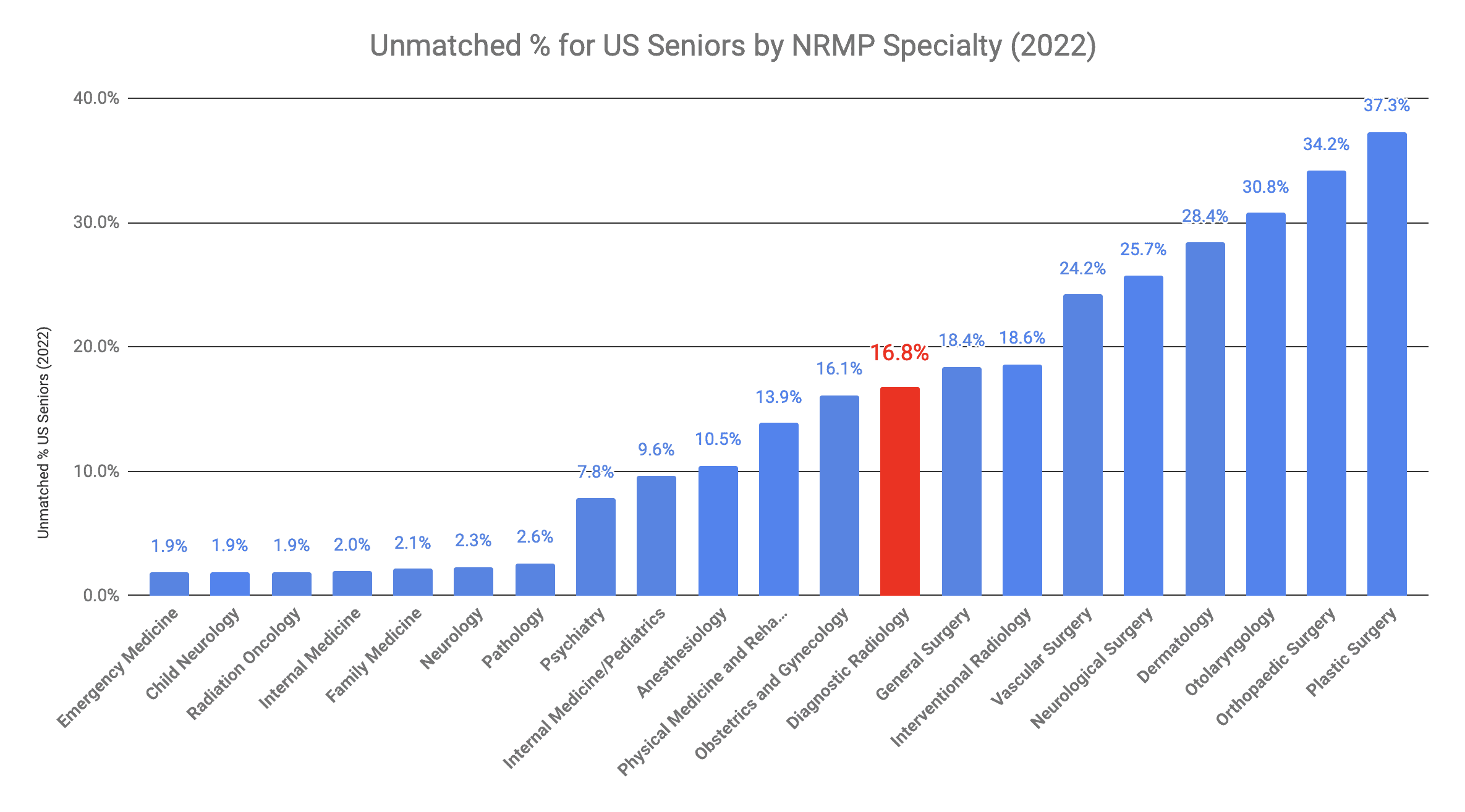
Diagnostic Radiologist Annual Compensation
One stereotype of diagnostic radiologists is that they make a lot of money. Diagnostic radiologists have an average annual salary of $437,000. But, this varies depending on the practice setting, specialty training, and experience level.
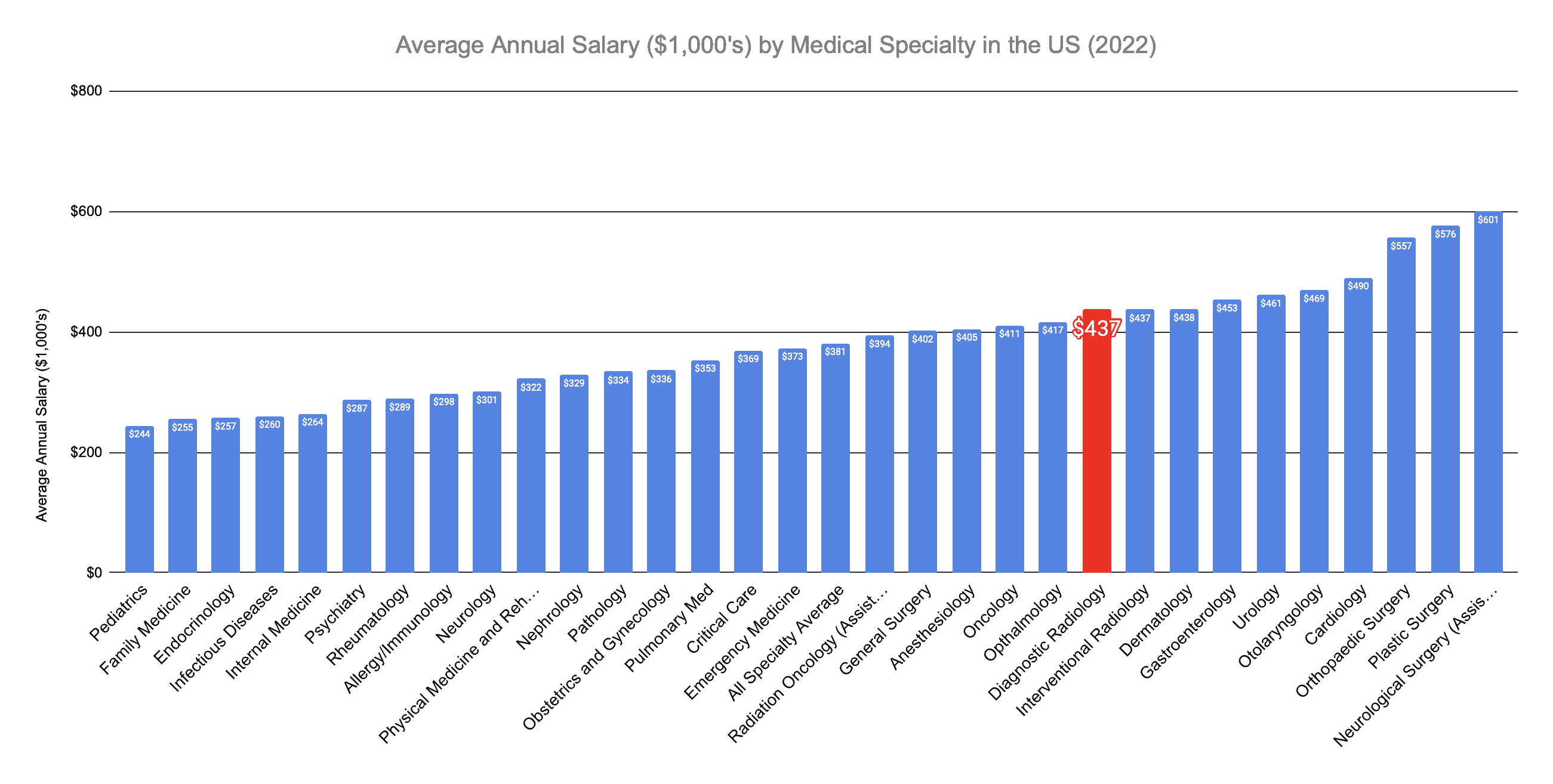
Diagnostic Radiologists make $437,000 per year on average
How Much Do Diagnostic Radiologists Make an Hour?
You may also wonder, how much do diagnostic radiologists make per hour? And how is the balance between time inside vs. outside the hospital for the specialty?
While there isn’t perfect data, we’ve compiled data re: hours/weeks worked and annual salary for diagnostic radiology.
Here are the data:
| Average Annual Salary | Average Hourly Salary | On-Call Schedule | Hours/Week | Avg Weeks Worked/Year | |
|---|---|---|---|---|---|
| Allergy/Immunology | $298,000.00 | $125.93 | 49.3 | ||
| Anesthesiology | $405,000.00 | $146.24 | Medium | 61 | 45.4 |
| Cardiology | $490,000.00 | $177.54 | 57.5 | ||
| Critical Care | $369,000.00 | $114.91 | 66.9 | ||
| Dermatology | $438,000.00 | $211.11 | Low | 45.4 | 45.7 |
| Diagnostic Radiology | $437,000.00 | $170.46 | Low | 58 | 44.2 |
| Emergency Medicine | $373,000.00 | $169.59 | Medium | 46.4 | 47.4 |
| Endocrinology | $257,000.00 | $110.40 | Medium | 48.5 | |
| Family Medicine | $255,000.00 | $101.85 | Medium | 52.6 | 47.6 |
| Gastroenterology | $453,000.00 | $168.53 | Medium | 56 | 47.7 |
| General Surgery | $402,000.00 | $141.88 | High | 59.4 | 47.7 |
| Infectious Diseases | $260,000.00 | $101.44 | High | 53.4 | |
| Internal Medicine | $264,000.00 | $100.81 | Medium | 54.9 | 47.7 |
| Interventional Radiology | $437,000.00 | ||||
| Nephrology | $329,000.00 | $122.40 | Medium | 56 | |
| Neurological Surgery (Assistant Prof. Median) | $600,500.00 | $214.96 | Medium | 58.2 | |
| Neurology | $301,000.00 | $129.09 | Medium | 50.8 | 45.9 |
| Obstetrics and Gynecology | $336,000.00 | $123.26 | Medium | 58 | 47 |
| Oncology | $411,000.00 | $143.43 | Low | 59.7 | |
| Opthalmology | $417,000.00 | $173.97 | Medium | 51 | 47 |
| Orthopaedic Surgery | $557,000.00 | $207.91 | Medium | 57 | 47 |
| Otolaryngology | $469,000.00 | $184.01 | High | 53.1 | 48 |
| Pathology | $334,000.00 | $147.74 | Low | 47.1 | |
| Pediatrics | $244,000.00 | $108.16 | Medium | 47 | 48 |
| Physical Medicine and Rehabilitation | $322,000.00 | $147.76 | 45.4 | ||
| Plastic Surgery | $576,000.00 | $230.77 | Medium | 52 | |
| Psychiatry | $287,000.00 | $131.04 | Low | 46.5 | 47.1 |
| Pulmonary Med | $353,000.00 | $119.77 | Medium | 61.4 | |
| Radiation Oncology (Assistant Prof. Median) | $393,734.00 | $158.36 | Low | 51.8 | |
| Rheumatology | $289,000.00 | $112.33 | 53.6 | ||
| Urology | $461,000.00 | $172.49 | High | 58.1 | 46 |
| Total Average | $381,233.35 | $147.44 | 53.9 |
And the estimated physician salary per hour by specialty (diagnostic radiology highlighted in red):
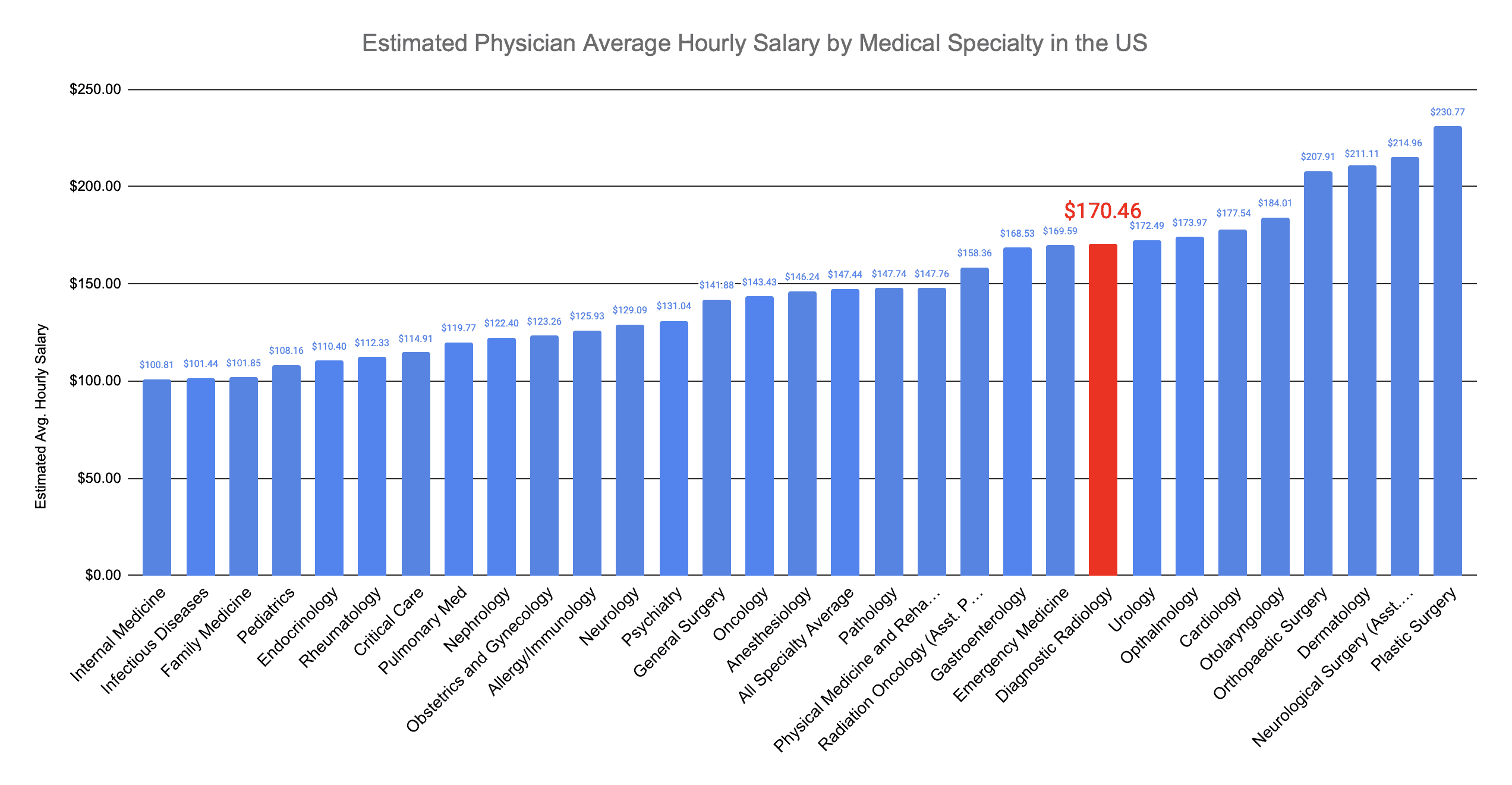
Diagnostic Radiologists make $170 an hour on average
Note: In the absence of data for weeks worked per year, 48 weeks was the estimate used to calculate the estimated hourly salary.
Getting AOA (Med School Honors) Helps in Becoming a Diagnostic Radiologist
Medical school is one of the most challenging aspects of becoming a doctor. Many medical schools have established Alpha Omega Alpha (AOA) branches to recognize top students.
AOA is the medical school honors society for students who excel in their studies and show an exemplary commitment to professionalism and leadership. Each medical school may elect up to 20% of their graduating class to get into AOA.
Induction into AOA is a prestigious honor that carries with it a variety of benefits. AOA members may be eligible for special scholarships and fellowships. They can often receive priority consideration for residency positions.
The AOA advantage is notable for the most competitive residency programs. The 2022 Match data showed that the match rate for US medical school seniors with AOA membership was 17% greater than that of US seniors without AOA membership in diagnostic radiology. In other words, AOA membership provided a good advantage to matching into a residency.
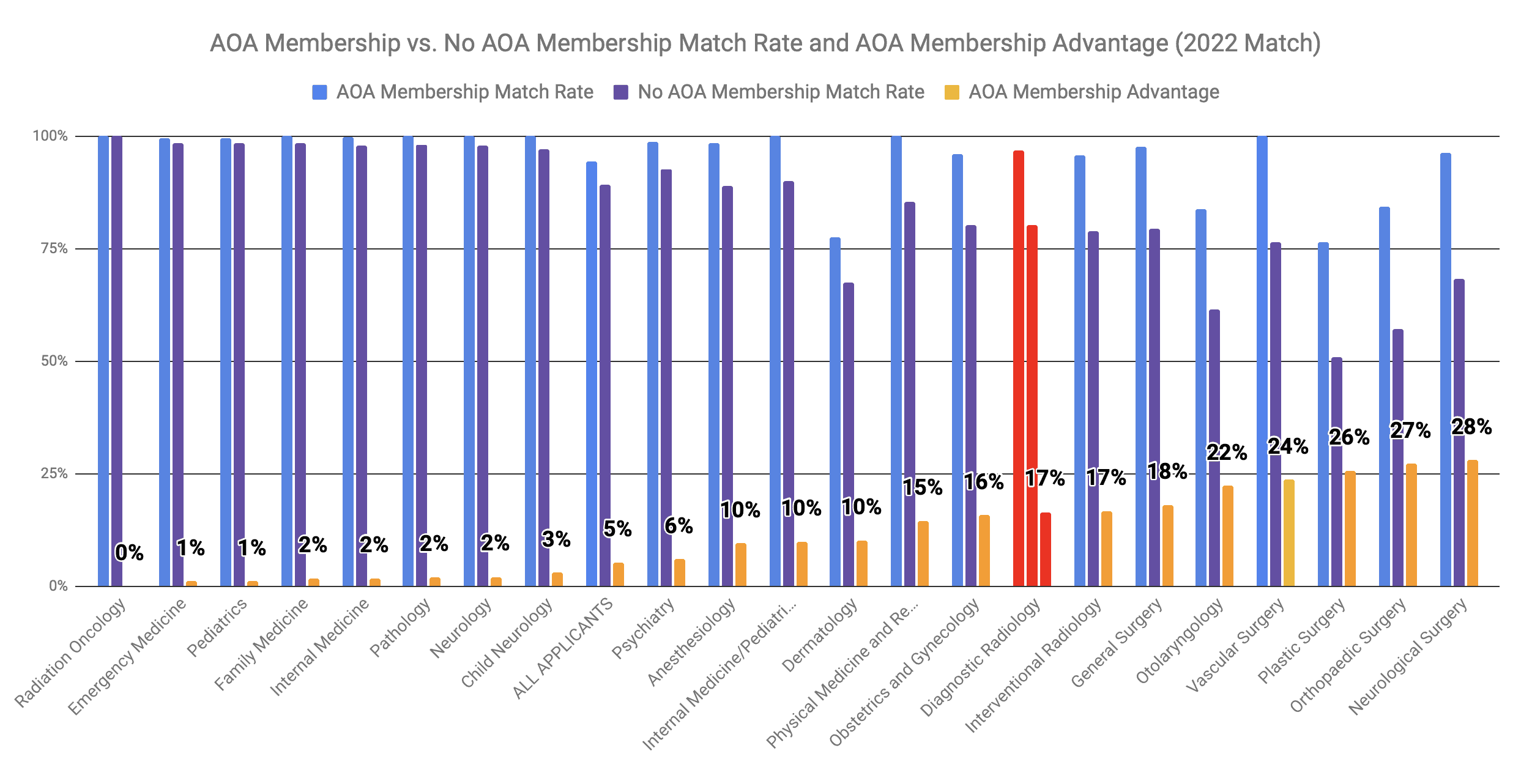
AOA membership correlated with a 17% match rate advantage for diagnostic radiology in the 2022 Match
See this article for more on AOA medical schools and the importance of class rank for matching.
Do You Need to Attend a Top School to Become a Diagnostic Radiologist?
In diagnostic radiology, attending a top medical school can make all the difference. According to a survey of program directors, over half of those surveyed reported considering applicants’ med school reputation when considering whom to interview, giving it an importance score of 3.9 out of 5.
Graduating from a top 40 school for NIH funding increases the likelihood of matching into diagnostic radiology by 7%. This is because top medical schools have more resources and access to clinical experience, which can help prepare students for the rigors of the specialty.
That said, it is important to remember that the name of the school alone does not guarantee success in any field. While attending a top medical school may have advantages, it is up to the individual to make the most of the opportunities presented. And while there is an advantage to being from a more prestigious institution, one’s record at the school will matter. This will include things like USMLE scores, class rank, and letters of recommendation.
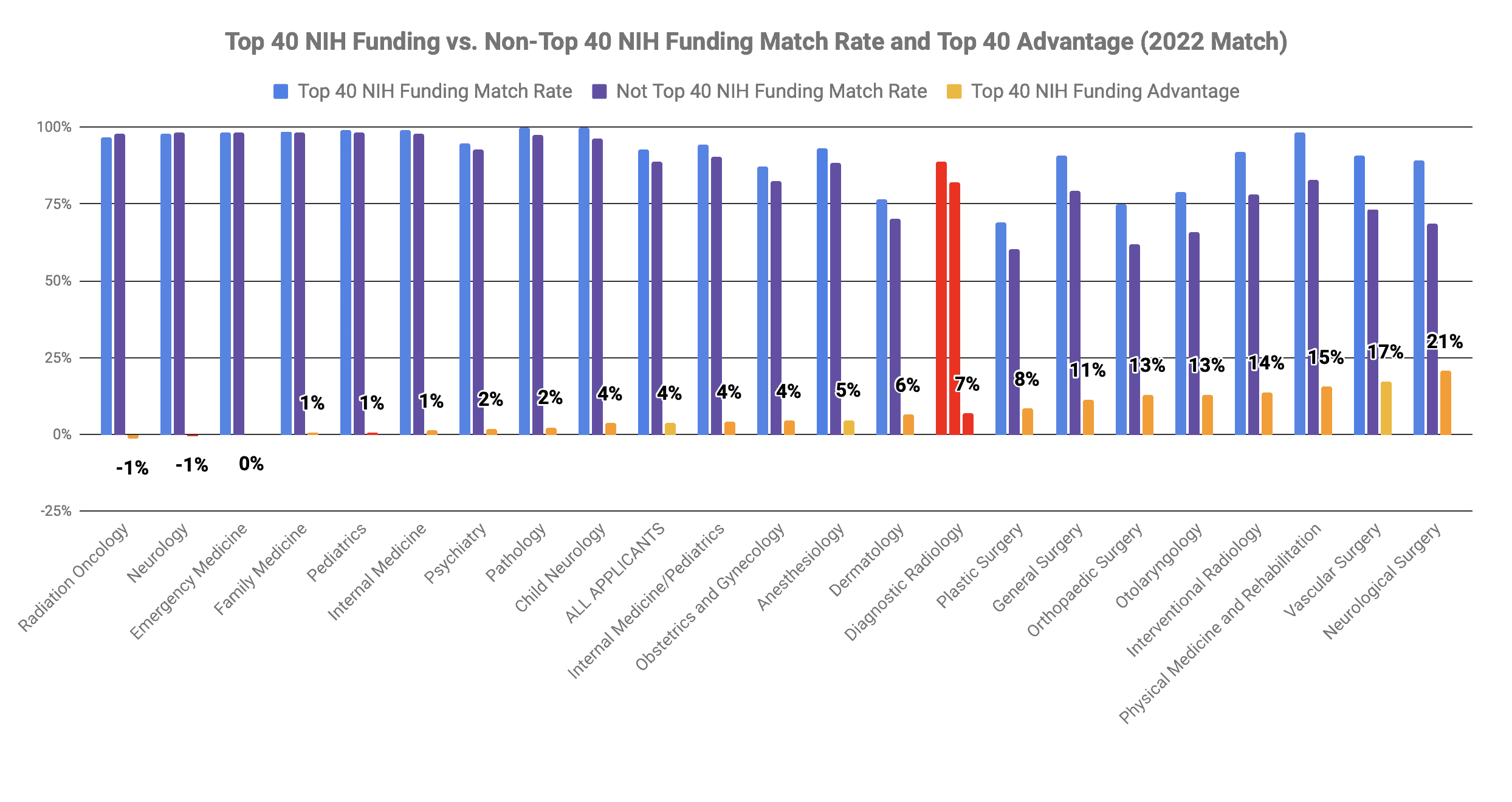
Graduating from a medical school ranked in the top 40 by NIH funding correlated with a 7% match rate advantage for diagnostic radiology in the 2022 Match
Does an MPH or MBA Help You Become a Diagnostic Radiogist?
Medical training is long and arduous. Students often consider earning other degrees before, after, or even during their medical studies. Having a Master of Public Health (MPH) or MBA may be appealing to potential diagnostic radiologist residents. But are these degrees helpful in residency applications?
Having an extra degree may not matter as much as one thinks. We crunched the numbers on the match rate for graduating students from MD schools for those with non-PhD other degrees vs. those that did not have a second degree. In diagnostic radiology, the match rate advantage was 1% for those with degrees like an MPH or MBA. This implies that having a second degree that isn’t a PhD doesn’t appear to help your chances of matching into diagnostic radiology.
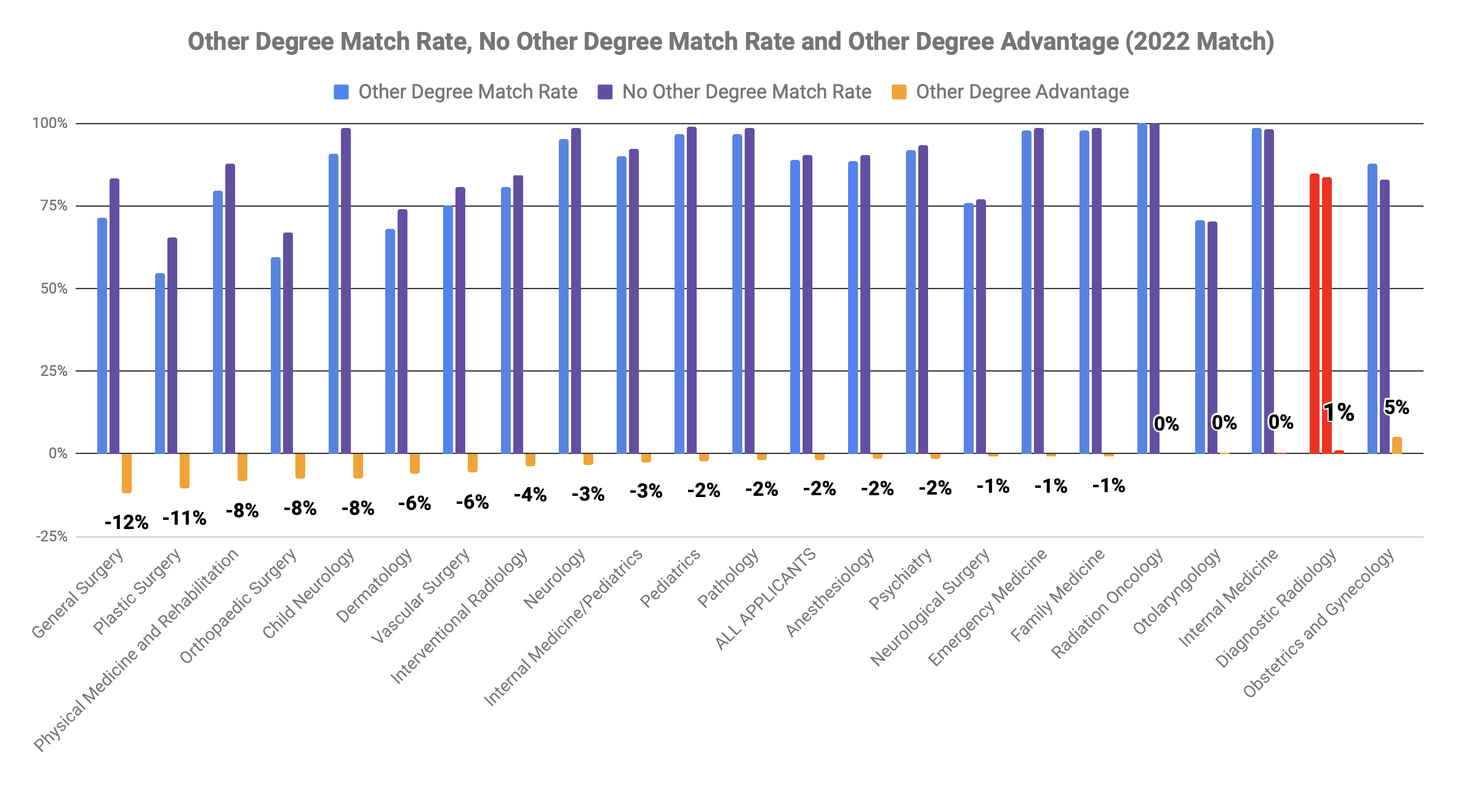
Having another degree like an MBA or MPH correlated with a 1% match rate disadvantage for diagnostic radiology in the 2022 Match
Note that this study only looked at the match rates of medical students with another degree. The data doesn’t look at the type of degree, the school, and the quality of the applicant’s credentials.
Having a second degree could open up some more career opportunities. An MPH or MBA may prove beneficial for those looking to get into healthcare administration or research.
Concluding Thoughts
Becoming a diagnostic radiologist is a challenging but rewarding career path. It is perfect for those who love anatomy, physiology, visualization, and problem-solving. With hard work, dedication, and a desire to help others, radiologists can make a real difference in the world of healthcare.
Looking for a Diagnostic Radiology Residency Advisor?
Looking for a diagnostic radiology residency advisor? Want help writing your personal statement? Need effective strategies for interviewing? Do you have things on your application – e.g., low USMLE scores, failed USMLEs, no research, IMG status, or others – you need help overcoming?
Be sure to check out our Residency Advisor service.







